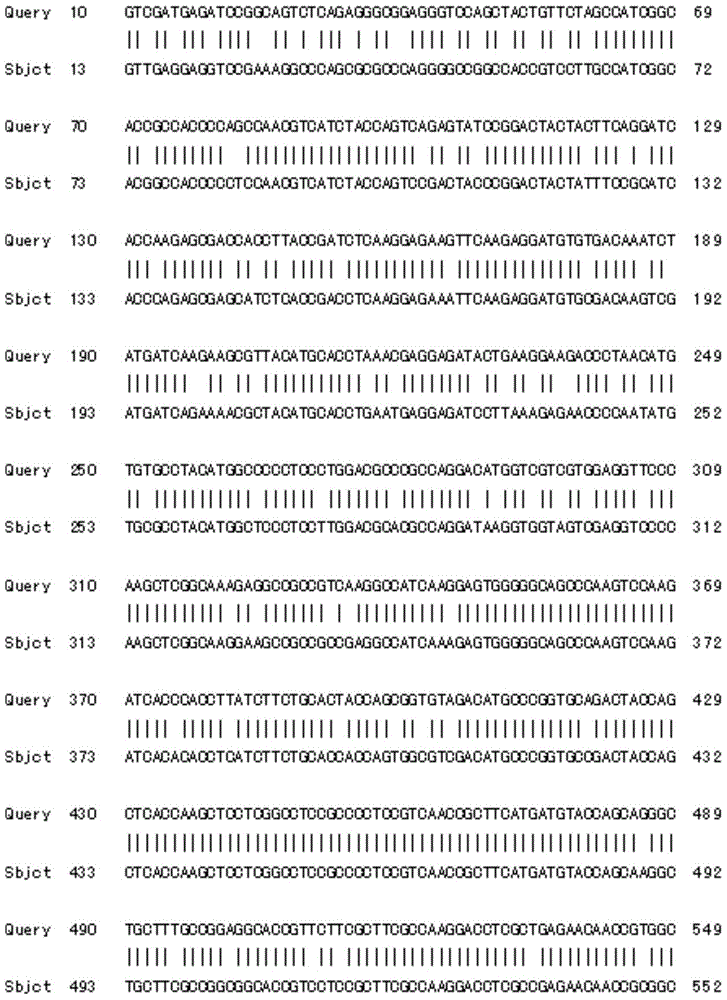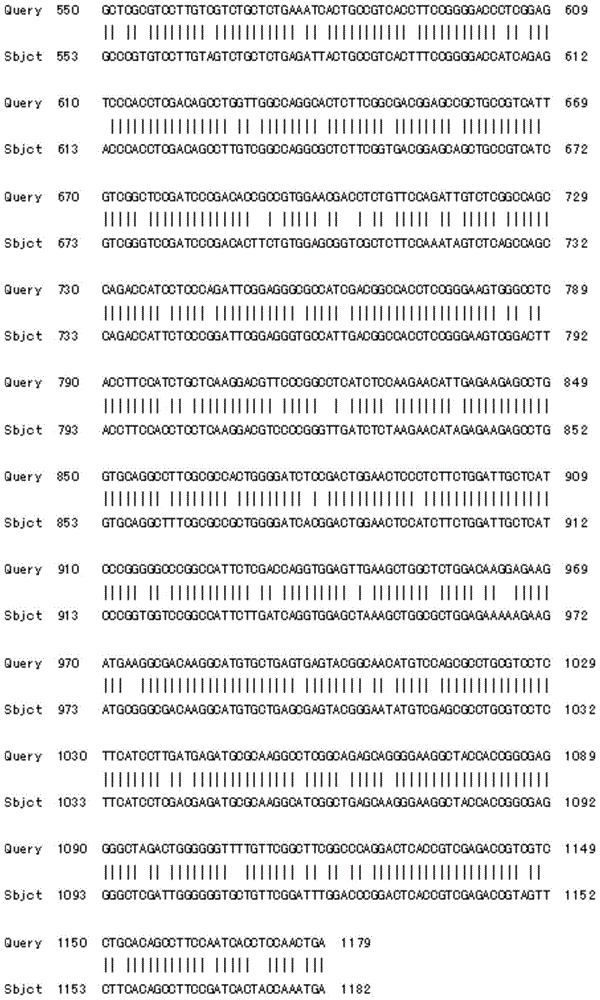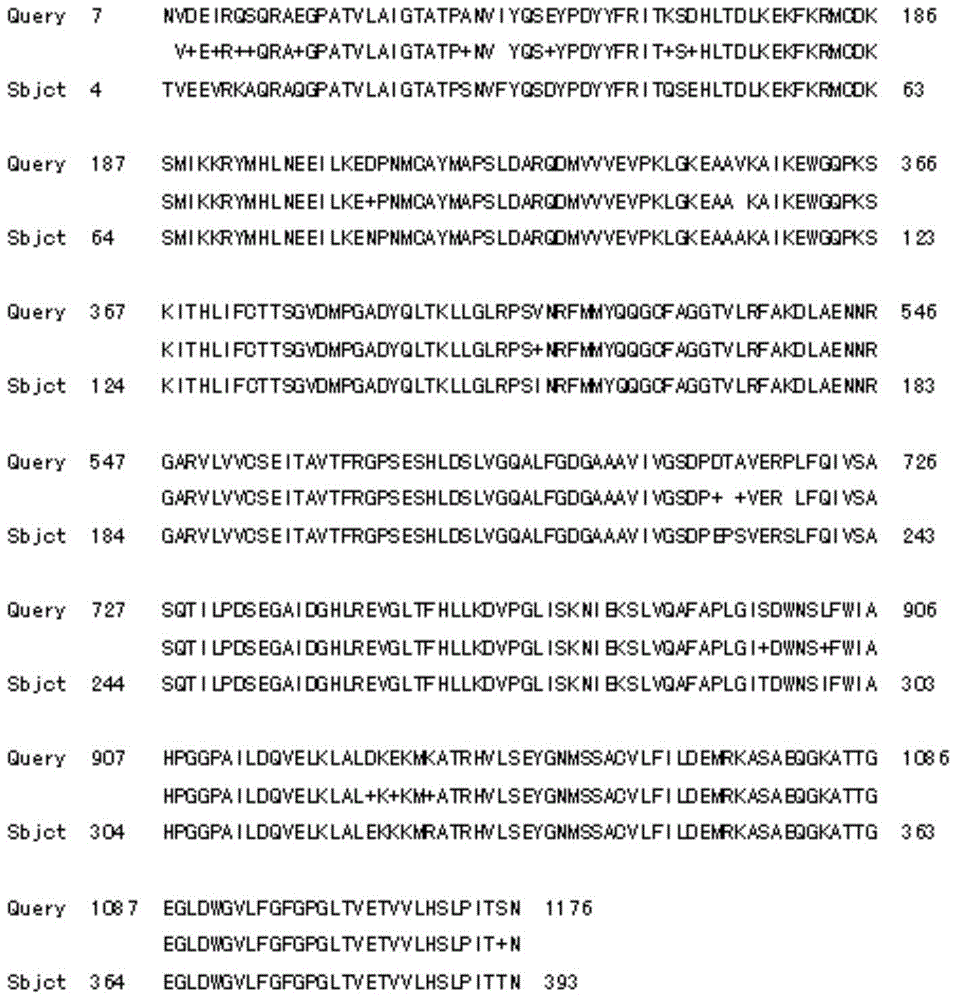Tulip chalcone synthase tfchs protein and its coding gene
A chalcone synthase, tulip technology, applied in genetic engineering, plant genetic improvement, enzymes and other directions, can solve problems such as the absence of tulip CHS protein
- Summary
- Abstract
- Description
- Claims
- Application Information
AI Technical Summary
Problems solved by technology
Method used
Image
Examples
Embodiment 1
[0045] Example 1 , Tulip TfCHS gene cloning
[0046] 1. Acquisition of plant material
[0047] Healthy, uniform-sized tulip bulbs (Tulipa fosteriana 'Shangnongzaoxia', approved by the Shanghai Crop Variety Approval Committee. No.: Shanghai Nongpin Huahua 2011 No. 004) were planted and managed in the field according to the routine, and the flowers were fully opened. Petal tissue was collected when the petals were fully colored for RNA extraction.
[0048] 2. Extraction of RNA
[0049] Total RNA was extracted with "RNA prep pure Plant Total RNA Extraction Kit" (RNA prep pure PlantKit: Tiangen Biochemical Technology (Beijing) Co., Ltd.). The integrity of RNA was identified by formaldehyde denaturing gel electrophoresis, and then the purity and concentration of RNA were determined on a spectrophotometer (Thermo Scientific NANODROP1000 Spectrophotometer).
[0050] 3. Full-length cloning of genes
[0051] According to the conserved amino acid sequence of the CHS gene, using th...
Embodiment 2
[0062] Example 2 , Sequence information and homology analysis of the TfCHS gene of tulip
[0063] The full-length CDS open reading frame sequence of tulip TfCHS is 1179bp. For the detailed sequence, see the sequence shown in SEQ ID NO.3. According to the CDS open reading frame sequence, the amino acid sequence of tulip TfCHS is deduced, with a total of 392 amino acid residues and a molecular weight of 42861.3 lanes It has an isoelectric point (pI) of 5.90, and its detailed sequence is shown in SEQ ID NO.4.
[0064] The CDS open reading frame sequence of tulip TfCHS and the amino acid sequence of its encoded protein were analyzed by BLAST program in Non-redundant GenBank+EMBL+DDBJ+PDB and Non-redundant GenBank CDS translations+PDB+SwissProt+Superdate+PIR database Acid and protein homology search, it was found that it has 86% identity with lily CHS gene (GenBank accession number HQ161731.1) at the nucleotide level, such as figure 1 and figure 2 shown; at the amino acid lev...
Embodiment 3
[0065] Example 3 , Expression difference of tulip TfCHS gene in different developmental stages of flowers and in different tissues of tulip
[0066] 1. Acquisition of materials
[0067] In the 4 different developmental stages of tulip flowers (buds, petals are not colored; buds, petals are beginning to color; flowers are partially open, petals are not fully colored; flowers are fully open, petals are fully colored), the petals are collected in the field, and the leaves are collected at the same time , aerial stems, stamens, pistils, and petals (mixed samples of petals at each coloring stage), the samples were wrapped in aluminum platinum paper and immediately put into liquid nitrogen, and then transferred to -80°C ultra-low temperature refrigerator for storage until use.
[0068] 2. Extraction of RNA
[0069] RNA prep pure Plant Total RNA Extraction Kit (RNA prep pure Plant Kit: Tiangen Biochemical Technology (Beijing) Co., Ltd.) was used to extract the petals of tulip flow...
PUM
 Login to View More
Login to View More Abstract
Description
Claims
Application Information
 Login to View More
Login to View More - R&D
- Intellectual Property
- Life Sciences
- Materials
- Tech Scout
- Unparalleled Data Quality
- Higher Quality Content
- 60% Fewer Hallucinations
Browse by: Latest US Patents, China's latest patents, Technical Efficacy Thesaurus, Application Domain, Technology Topic, Popular Technical Reports.
© 2025 PatSnap. All rights reserved.Legal|Privacy policy|Modern Slavery Act Transparency Statement|Sitemap|About US| Contact US: help@patsnap.com



